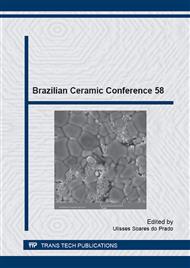[1]
C.F. Ferraris et al: Cement Concrete and Aggregates Vol 20 (2) (1988), p.241.
Google Scholar
[2]
3M Glass Bubbles K Series, S Series and iM Series. Link < http: /multimedia. 3m. com/mws/mediawebserver?mwsId=tttttviZIdW5_y7VqyAtoz0t2XV62EW9iXut2Xut2tttttt-&fn=GlassMicrospheresKS_Series_Celum_9838591_R2. pdf >.
Google Scholar
[3]
American Society for Testing and Materials - ASTM. Standard Specification for Chemical Admixtures for Concrete. ASTM C494/C494M (2013). West Conshohocken, PA, USA. (2013).
Google Scholar
[4]
G.E.P. Box, W.G. Hunter, J.S. Hunter, W.G. Hunter: Statistics for Experimenters: An Introduction to Design, Data Analysis, and Model Building. (John Wiley New York, 1978).
DOI: 10.1177/014662168000400313
Google Scholar
[5]
P.K. Mehta, P.J.M. Monteiro: Concrete: Microstructure, Properties, and Materials. (McGraw-Hill New York, 2006).
Google Scholar
[6]
American Society for Testing and Materials - ASTM. Practice for Making and Curing Concrete Test Specimens in the Laboratory. ASTM C192/C192M (2013). West Conshohocken, PA, USA. (2013).
Google Scholar
[7]
American Society for Testing and Materials - ASTM. Standard Test Method for Slump of Hydraulic - Cement Concrete. ASTM C143/C143M (2012). West Conshohocken, PA, USA. (2012).
Google Scholar
[8]
American Society for Testing and Materials - ASTM. Standard Practice for Making Test Cylinders and Prisms for Determining Strength and Density of Preplaced-Aggregate Concrete in the Laboratory. ASTM C943 (2010). West Conshohocken, PA, USA. (2010).
DOI: 10.1520/c0943-17
Google Scholar
[9]
I.R. Oliveira, A.R. Studart, R.G. Pileggi, V.C. Pandolfelli: Dispersão E Empacotamento De Partículas: Princípios Básicos E Aplicações Em Processamento Cerâmico. (Fazendo Arte Editorial São Paulo, 2000).
Google Scholar
[10]
American Society for Testing and Materials - ASTM. Standard Specification for Mixing Rooms, Moist Cabinets, Moist Rooms, end Water Storage Tanks Used in the Testing of Hydraulic Cements and Concrete. ASTM C511 (2013).
DOI: 10.1520/c0511-03
Google Scholar
[11]
American Society for Testing and Materials - ASTM. Standard Test Method for Pulse Velocity Through Concrete. ASTM C597 (2009). West Conshohocken, PA, USA. (2009).
Google Scholar
[12]
American Society for Testing and Materials - ASTM. Standard Test Method for Compressive Strength of Cylindrical Concrete Specimens. ASTM C39/C39M (2014). West Conshohocken, PA, USA. (2014).
Google Scholar
[13]
W.A. Weibull: Applicability J. Appl. Mech. Vol. 18 (3) (1951), p.293.
Google Scholar
[14]
A. Lorenzi, L.F. Caetano, M.T. Drunn, L.C.P. Silva Filho: Utilização de ultra-som para o monitoramento de estruturas de concreto. Rio de Janeiro RJ. III Pan-American Conference for Nondestructive Testing. PANNDT. Junho (2003).
Google Scholar


